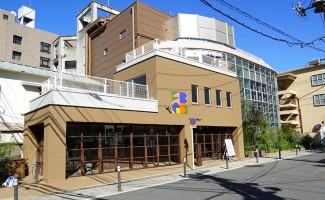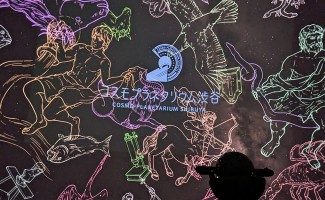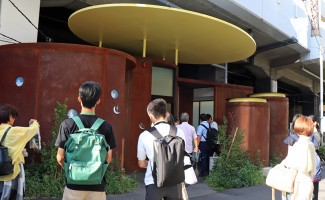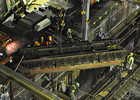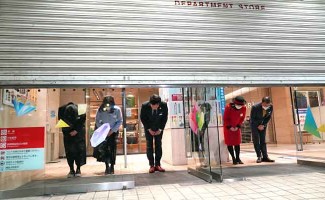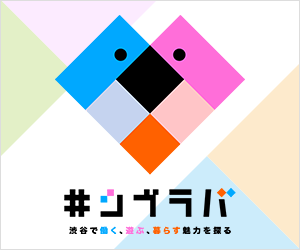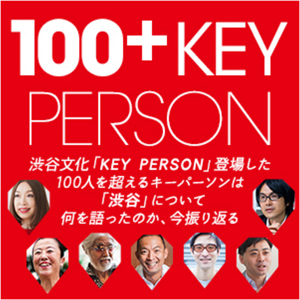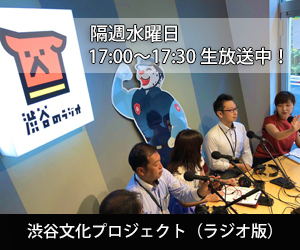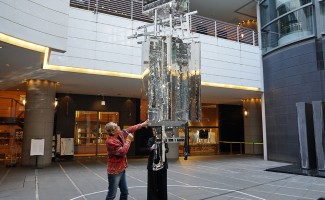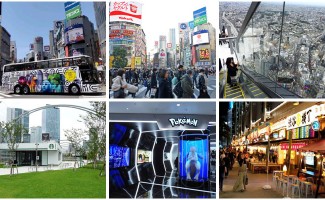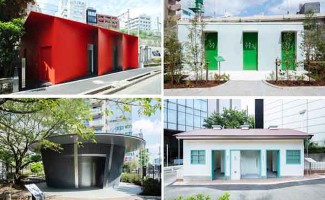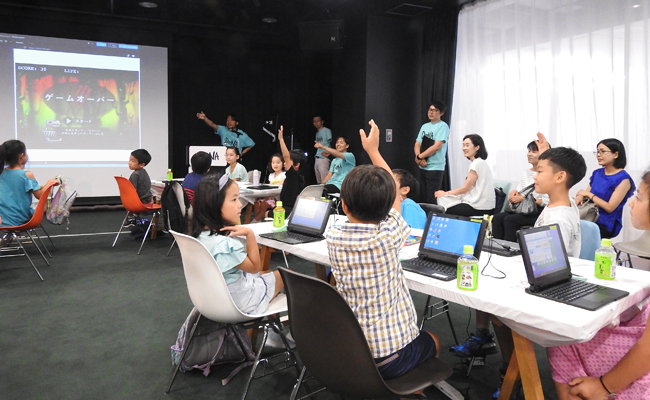
Toward 2020 programming education, Tokyu and four major IT companies start "Kids VALLEY"!
Currently, "programming" is the top of the lessons that parents want their children to attend along with "English". In the era when IoT and AI become mainstream, much attention has been paid to “programming languages” that promote communication between people and computers. In particular, since 2016, the Ministry of Education, Culture, Sports, Science and Technology announced “Mandatory programming education” at elementary schools in FY2020, and the heat has accelerated rapidly. I'm sure you'll feel it if you have a child.
| "Return to Shibuya" An IT company produced by Shibuya nurtures the next generation of children
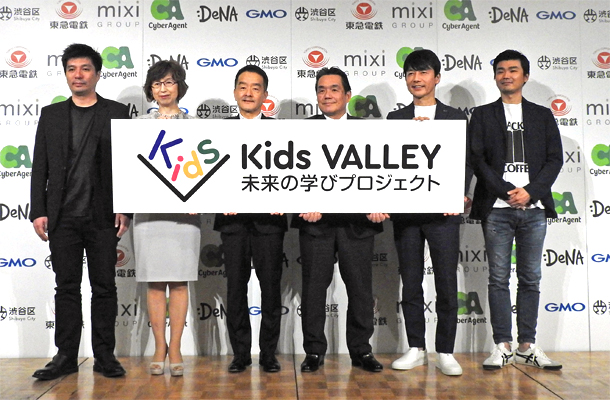 ▲ The conclusion of the agreement. From the left, Cyber Agent Kei Fujita President, DeNA Chairman Tomoko Minamiba, TOKYU CORPORATION President Kazuo Takahashi, Hirotoshi Toyooka, Board of Education, Shibuya Ward Chairman, GMO Masatoshi Kumagaya Chairman and President / Group Representative, Hiroshi Kimura President
▲ The conclusion of the agreement. From the left, Cyber Agent Kei Fujita President, DeNA Chairman Tomoko Minamiba, TOKYU CORPORATION President Kazuo Takahashi, Hirotoshi Toyooka, Board of Education, Shibuya Ward Chairman, GMO Masatoshi Kumagaya Chairman and President / Group Representative, Hiroshi Kimura President
Shibuya Ward has been promoting the ICT education system since September 2017 by distributing one tablet-type device to all ward elementary and junior high school students. The Shibuya Ward Board of Education will be based in Shibuya in June this year, aiming to make programming education mandatory at elementary schools from next year and junior high school from 2021. TOKYU CORPORATION Signed an “Program Education Business Agreement” with four major IT companies, CyberAgent, DeNA, GMO Internet, and Mixi, and at the same time enhanced programming education at Shibuya City elementary and junior high schools The “Kids Valley Future Learning Project” has started.
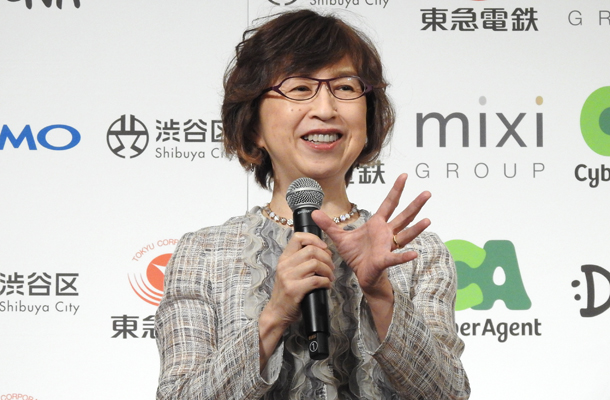 DeNA Chairman Tomoko Minamiba, who participated in the agreement conclusion ceremony, praised programming education as “programming is a great effort that allows us to wear passion and creativity collaboration, which are the disadvantages of the traditional educational system”.
DeNA Chairman Tomoko Minamiba, who participated in the agreement conclusion ceremony, praised programming education as “programming is a great effort that allows us to wear passion and creativity collaboration, which are the disadvantages of the traditional educational system”.
The project, which is made up of four core companies of Shibuya Bid Valley, which emerged in Shibuya from the late 1990s to the first half of 2000, is an effort to make the most of Shibuya's resources. Who would have imagined that an IT venture that had not been connected to the sea or the mountain about 20 years ago, has grown as a leading company today and is related to Shibuya in this way? It is a wonderful attempt for IT companies and human resources produced from Shibuya to be involved in the education of the children who will be responsible for the next Shibuya.
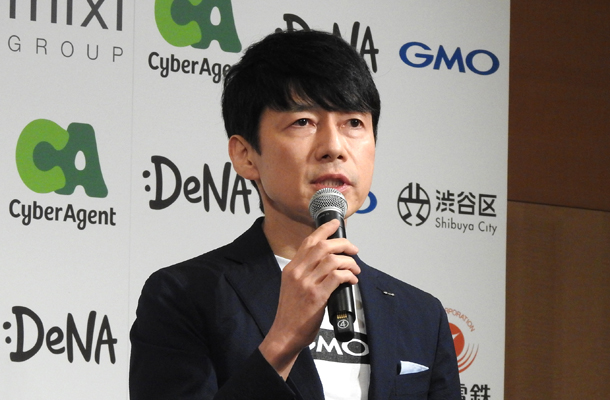 Mr. Masatoshi Kumagaya, Chairman, President and Group Representative of GMO Internet, said, “I want to give back to Shibuya (through programming support)”, “In this era, when I study programming languages that are machine languages as well as English and Chinese, "Life will change," appealed the need for "learning programming" to children.
Mr. Masatoshi Kumagaya, Chairman, President and Group Representative of GMO Internet, said, “I want to give back to Shibuya (through programming support)”, “In this era, when I study programming languages that are machine languages as well as English and Chinese, "Life will change," appealed the need for "learning programming" to children.
So what exactly will the four IT companies commit to the field of children's education? “Determining the company in charge by grade of elementary school and junior high school”, DeNA is “elementary school lower grade (1-3 years)”, cyber agent, GMO is “elementary school upper grade”, mixi is curriculum for “middle school” We will support classes that will become essential from next year, such as development and teacher training. “The big IT companies that represent Japan will support you…”, the other members of the municipal board of education must be looking at Shibuya with an eye for envy.
| Programming summer camp with elementary school students in Shibuya City
In August, the summer vacation, Cyber Agent, DeNA, GMO and Mixi held “Programming Summer Camp 2019” for elementary and junior high school students in Shibuya Ward. The plan is to have children experience the fun of programming and game development ahead of full-scale start next year. The venue is where you can see the work of programmers and engineers using the offices of each company. I'm sure there were children who made their dreams come true by close to professional work, how they make games they play.
In this report, DeNA Shibuya Hikarie I would like to introduce the details of the summer camp that was held in
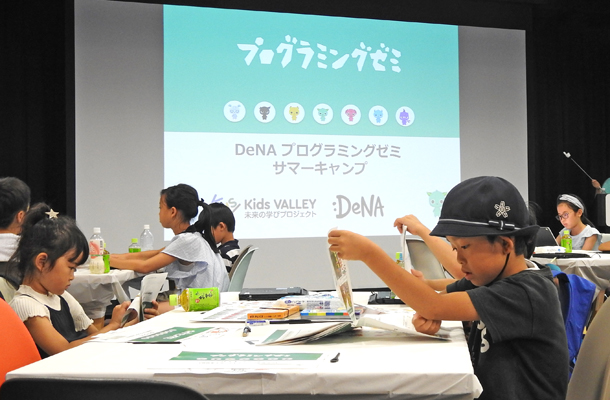 28 children participated in the event for elementary school 1st to 6th graders living and living in Shibuya Ward. DeNA received a request from Shibuya Ward for several years and has a track record of teaching at several elementary schools in the Ward. The company has developed a programming learning app called “Programming Seminar” that enables students to learn programming concepts visually by connecting blocks, especially for first graders in elementary school who touch a computer for the first time. It has already been used at the educational sites of elementary schools in the city, and at this event, a workshop was held using the latest version of the app.
28 children participated in the event for elementary school 1st to 6th graders living and living in Shibuya Ward. DeNA received a request from Shibuya Ward for several years and has a track record of teaching at several elementary schools in the Ward. The company has developed a programming learning app called “Programming Seminar” that enables students to learn programming concepts visually by connecting blocks, especially for first graders in elementary school who touch a computer for the first time. It has already been used at the educational sites of elementary schools in the city, and at this event, a workshop was held using the latest version of the app.
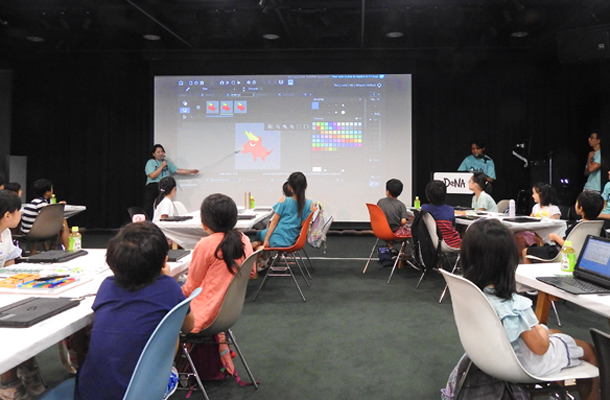 ▲ Promote the creation of game characters while talking with children
▲ Promote the creation of game characters while talking with children
Before the workshop, Fumitoshi Ogata, a programmer involved in game development at DeNA, performed “Live Coding”. For this day, Ogata-san proceeded with coding while interacting with elementary school students, with an action game featuring a dinosaur that had been preparing for a month ago. For example, "Is this the size of a dinosaur?" "What will come out of the mouth? Is it a fire?" "What kind of dinosaur should the enemy be?" In addition, "I will take damage when a dinosaur and an enemy collide. This is called" winning judgment "in industry terminology. Please remember this and return home today." While intermingling the terms and information, I showed a glimpse of a part of the game programmer's work.
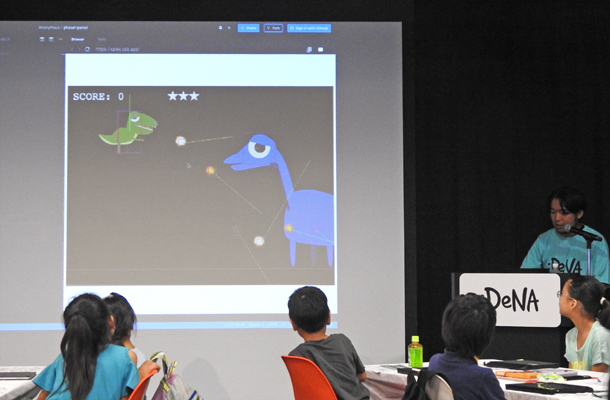 ▲ Coding attacks and character movements
▲ Coding attacks and character movements
The children also got a chance to know how the games they are always playing and how they got out and stared at live coding
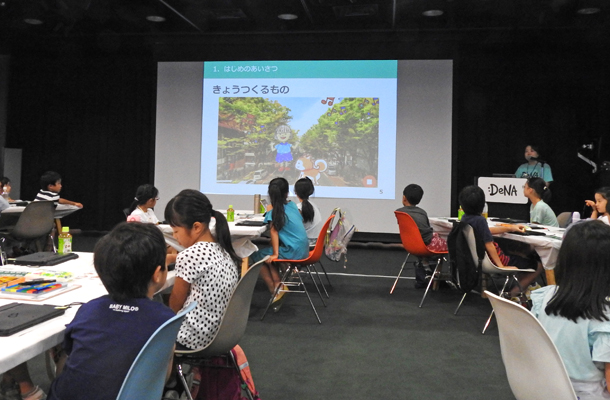 ▲ The theme of this workshop is “Make an animation inspired by Shibuya!”
▲ The theme of this workshop is “Make an animation inspired by Shibuya!”
After the live coding, a workshop where the children actually moved their hands started. DeNA Shosuke, a developer of programming learning application "Programming Seminar" explained the workshop procedure. This time, the theme is “Let's make an animation that looks like Shibuya!” Taking pictures of the characters and illustrations of Hachiko, balloons, notes, stars, and other decorations that you drew, and importing them to your computer, with the background of the city of Shibuya Produce animation.
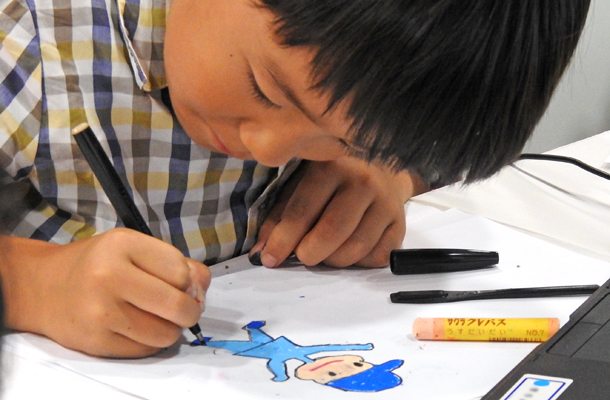 First of all, children make characters with their own feelings.
First of all, children make characters with their own feelings.
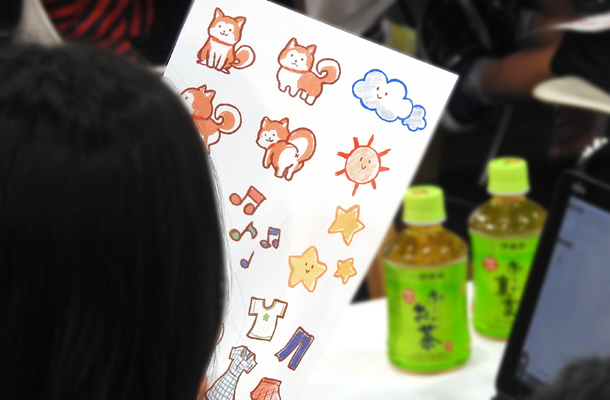 There are several photos and sheets that you can use from Hachiko, illustrations such as decorations, and the scenery of the city of Shibuya.
There are several photos and sheets that you can use from Hachiko, illustrations such as decorations, and the scenery of the city of Shibuya.
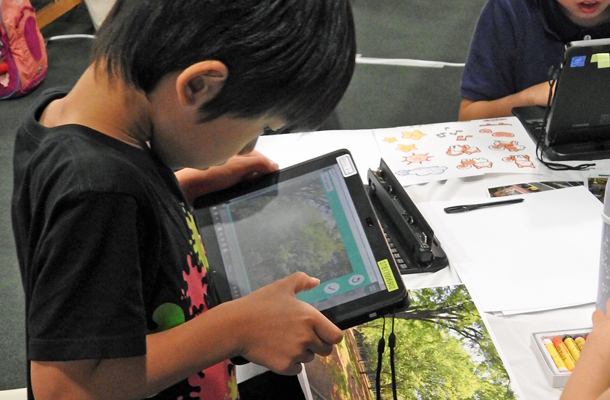 Capture and capture drawn characters and illustrations on a computer.
Capture and capture drawn characters and illustrations on a computer.
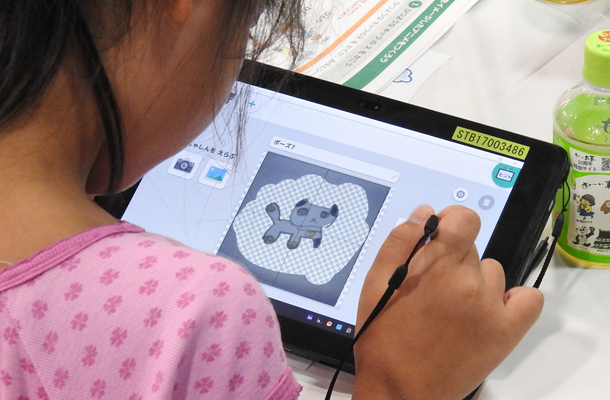 Unnecessary parts of the imported photo are erased with the eraser tool, and the illustration is trimmed (cut out) neatly.
Unnecessary parts of the imported photo are erased with the eraser tool, and the illustration is trimmed (cut out) neatly.
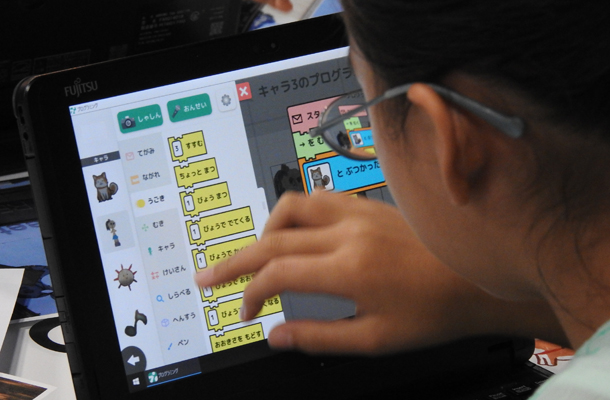 Characters, Hachiko, decorations, etc. are placed on the background of the city of Shibuya, such as `` Susumu '', `` A little pine '', `` Hit the second (second) '', `` Crashed with 000 '', `` Swivel '' While changing visual objects, children add movement to each character and decoration. Unlike programming languages used by professional programmers, the program is advanced while moving the visualized blocks back and forth.
Characters, Hachiko, decorations, etc. are placed on the background of the city of Shibuya, such as `` Susumu '', `` A little pine '', `` Hit the second (second) '', `` Crashed with 000 '', `` Swivel '' While changing visual objects, children add movement to each character and decoration. Unlike programming languages used by professional programmers, the program is advanced while moving the visualized blocks back and forth.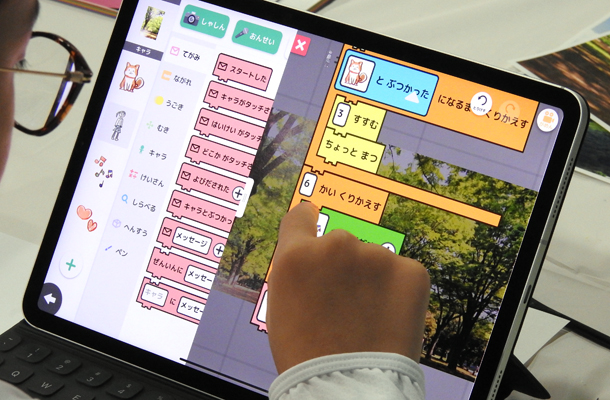 If you don't add “movement” in the correct order, each character will not move as expected. There were many children who checked the operation by changing the block over and over again, bothering their heads. This process is also a concept that is similar to the actual program, and it also leads to fostering logical thinking that breaks things down and thinks in order.
If you don't add “movement” in the correct order, each character will not move as expected. There were many children who checked the operation by changing the block over and over again, bothering their heads. This process is also a concept that is similar to the actual program, and it also leads to fostering logical thinking that breaks things down and thinks in order.
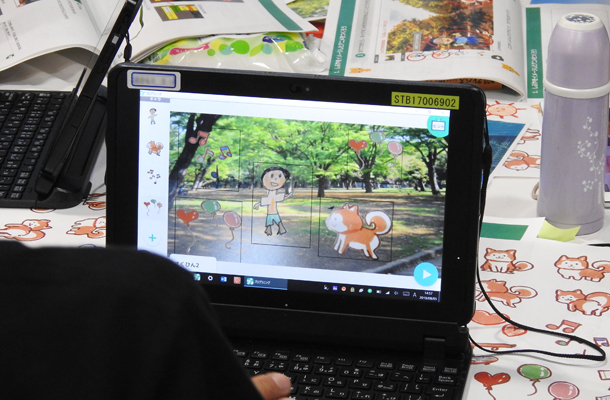 Speaking of elementary school children's play, it used to be the “palapara manga” that was drawn at the end of textbooks, but in the present age, it is an era when the pictures you draw can easily be animated on a tablet. The children's creativity is tested on what is expressed here.
Speaking of elementary school children's play, it used to be the “palapara manga” that was drawn at the end of textbooks, but in the present age, it is an era when the pictures you draw can easily be animated on a tablet. The children's creativity is tested on what is expressed here.
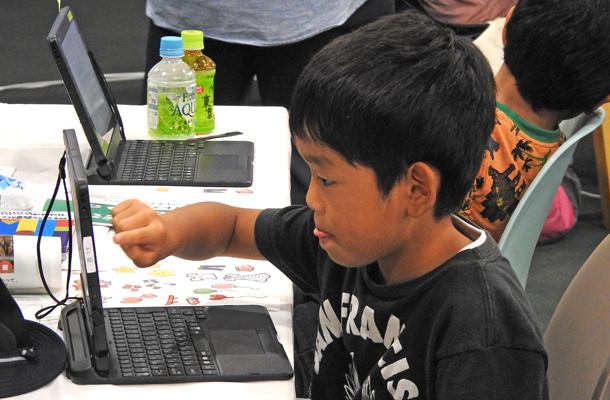
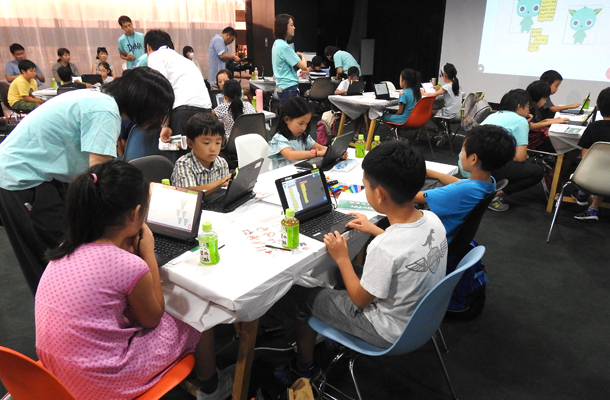 The workshop that started at 13:00 was held for 3 hours until 16:00 in the evening, with a break in the middle. It wasn't strange to have a child who was short of breath on the way, but seriously worked on the work while maintaining high concentration until the end. From the venue, the voice of “It was really fun” was also noticeable. Rather than "programming = difficult", it is important to first revive children's curiosity and exploration while having fun while playing.
The workshop that started at 13:00 was held for 3 hours until 16:00 in the evening, with a break in the middle. It wasn't strange to have a child who was short of breath on the way, but seriously worked on the work while maintaining high concentration until the end. From the venue, the voice of “It was really fun” was also noticeable. Rather than "programming = difficult", it is important to first revive children's curiosity and exploration while having fun while playing.
At the end of the workshop, Mr. Suehiro said, “The program seems to be difficult to do at first glance, but I think it was quite easy to do it. When I took my picture and saw my picture moving, It ’s great and fun, and I want you to move my favorite pictures more and more.
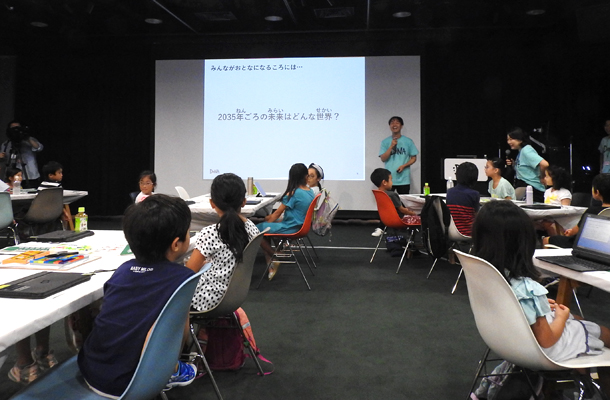 15 years later, when elementary school children now start working as adults, what kind of city is Shibuya in 2035? Do autonomous cars run and large drones deliver to the sky? In an era where everything is connected online and AI is incorporated, the demand for IT human resources, including programmers, will increase. According to a survey published by the Ministry of Economy, Trade and Industry in 2016, it is estimated that around 2030 IT personnel will be short. Although Japan has scarce resources, evolution and development in this field is strongly desired. I'm looking forward to seeing how “mandating programming education” at elementary schools from FY2020 will contribute to the foundation of IT human resource development.
15 years later, when elementary school children now start working as adults, what kind of city is Shibuya in 2035? Do autonomous cars run and large drones deliver to the sky? In an era where everything is connected online and AI is incorporated, the demand for IT human resources, including programmers, will increase. According to a survey published by the Ministry of Economy, Trade and Industry in 2016, it is estimated that around 2030 IT personnel will be short. Although Japan has scarce resources, evolution and development in this field is strongly desired. I'm looking forward to seeing how “mandating programming education” at elementary schools from FY2020 will contribute to the foundation of IT human resource development.

Editorial department · Fuji Itakashi
Shibuya registrar. In addition to Shibuya of Culture information, seasonal news and topics, it will spell write that feel every day.



